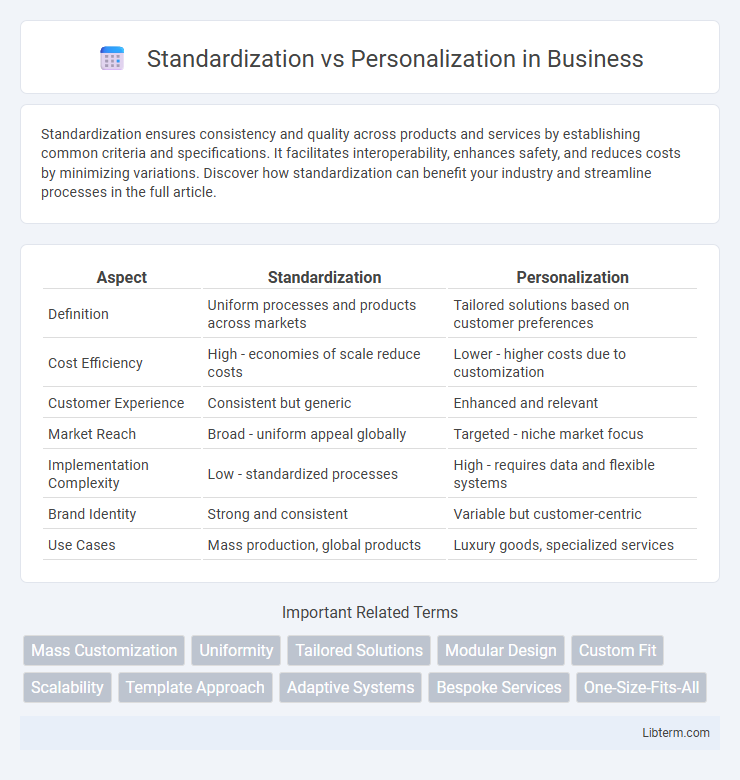Standardization ensures consistency and quality across products and services by establishing common criteria and specifications. It facilitates interoperability, enhances safety, and reduces costs by minimizing variations. Discover how standardization can benefit your industry and streamline processes in the full article.
Table of Comparison
| Aspect | Standardization | Personalization |
|---|---|---|
| Definition | Uniform processes and products across markets | Tailored solutions based on customer preferences |
| Cost Efficiency | High - economies of scale reduce costs | Lower - higher costs due to customization |
| Customer Experience | Consistent but generic | Enhanced and relevant |
| Market Reach | Broad - uniform appeal globally | Targeted - niche market focus |
| Implementation Complexity | Low - standardized processes | High - requires data and flexible systems |
| Brand Identity | Strong and consistent | Variable but customer-centric |
| Use Cases | Mass production, global products | Luxury goods, specialized services |
Introduction to Standardization and Personalization
Standardization involves implementing uniform processes and products to ensure consistency, efficiency, and quality across all operations. Personalization tailors experiences, products, or services to meet individual customer preferences and needs, enhancing engagement and satisfaction. Businesses balance these approaches to optimize scalability while delivering customized value.
Defining Standardization in Modern Industries
Standardization in modern industries refers to the implementation of uniform processes, specifications, and criteria to ensure consistency, quality, and interoperability across products and services. It enables mass production efficiency, reduces costs, and simplifies regulatory compliance by adhering to established global or industry-specific standards. By minimizing variability, standardization supports scalability and facilitates seamless integration within supply chains and customer ecosystems.
The Essence of Personalization: Tailoring Experiences
Personalization involves tailoring experiences to individual preferences, behaviors, and needs, enhancing customer engagement and satisfaction. Unlike standardization, which applies uniform processes and products, personalization adapts content, services, and interactions based on data-driven insights and real-time feedback. This approach leverages advanced analytics and AI technologies to create unique, meaningful connections between brands and customers, driving loyalty and conversion rates.
Benefits of Standardization: Consistency and Efficiency
Standardization ensures consistency across products and services by maintaining uniform quality and performance standards, which enhances customer trust and brand reliability. It streamlines processes, reducing variability and minimizing errors, leading to improved operational efficiency and cost savings. Consistent practices enable faster training and scalability, making it easier for organizations to manage resources and expand effectively.
Advantages of Personalization: Customer Engagement and Loyalty
Personalization enhances customer engagement by delivering tailored experiences that resonate with individual preferences, increasing satisfaction and interaction. This targeted approach fosters loyalty as customers feel valued and understood, leading to higher retention rates and repeat business. Brands leveraging personalization benefit from improved customer lifetime value and stronger emotional connections.
Challenges Faced in Implementing Standardization
Implementing standardization faces challenges such as resistance from employees who prefer personalized approaches that accommodate individual work styles and local practices. Organizations struggle with balancing uniform processes while maintaining flexibility to adapt to diverse market demands and cultural differences. High initial costs and the complexity of aligning legacy systems and workflows further complicate the standardization process.
Obstacles to Achieving Effective Personalization
Obstacles to achieving effective personalization include data privacy concerns, which limit the collection and use of consumer information critical for tailored experiences. Inconsistent data integration across diverse platforms hinders the creation of a unified customer profile necessary for accurate personalization. Moreover, organizational resistance to change and high implementation costs pose significant barriers to replacing standardization with personalized strategies.
Striking the Right Balance: Hybrid Approaches
Hybrid approaches in business combine standardization and personalization to maximize efficiency while meeting diverse customer needs. Standardized processes ensure consistent quality and lower costs, whereas personalized experiences drive customer satisfaction and loyalty through tailored interactions. Striking the right balance involves leveraging data analytics to customize key touchpoints without sacrificing operational scalability.
Industry Case Studies: Standardization vs Personalization
Industry case studies reveal that companies like McDonald's leverage standardization to ensure consistent quality and efficiency across global locations, driving scalability and cost control. In contrast, brands such as Nike employ personalization strategies by offering customizable products, enhancing customer engagement and brand loyalty through tailored experiences. These examples highlight that while standardization excels in operational uniformity, personalization optimizes consumer satisfaction and differentiation in competitive markets.
Future Trends: Evolving Strategies in Standardization and Personalization
Future trends in standardization and personalization emphasize advanced AI-driven customization, enabling businesses to deliver hyper-personalized experiences while maintaining scalable standardized processes. The integration of machine learning algorithms with real-time data analytics fosters adaptive product offerings tailored to individual customer preferences without sacrificing consistency. Emerging technologies such as blockchain and IoT support transparent, secure personalization frameworks, driving innovation in seamless and efficient standardized service delivery.
Standardization Infographic

 libterm.com
libterm.com